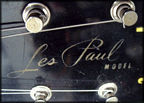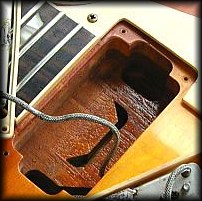
 |
| What is a PAF? | ||||
The
term PAF stands for Patent Applied For, which is a decal that Gibson affixed
to the bottom of their humbuckers in the late '50's and early '60's. The
term PAF has become a generic term for all Gibson humbuckers, which can
lead to confusion and misinformation. |
||||
| What is a ABR-1? | ||||
|
|
The ABR-1 is the original name of the Tuneomatic bridge used on Gibsons. An original ABR-1 will have 'ABR-1' cast into the bottom of the bridge. Later Tuneomatics will have a patent number cast into it. The early ABR-1 bridges did not have the retaining wire for the bridge saddles, though later on they did. Also, ABR-1 bridges used plated brass saddles, later ones were made from a different type of alloy. | |||
|
||||
| What are Bumblebees? | ||||
|
|
'Bumblebee' is a term used for the old black Sprague paper-in-oil molded caps. They used stripes to designate the values of the capacitors, they looked like bumblebee stripes.
|
|||
| What
does 500K mean? |
||||
This is the value of the potentiometers used in Les Pauls, although some during the Norlin years used 350K Ohm potentiometers. Most agree that 500K ohm is the best sounding value for humbuckers More Pot Talk Potentiometer Comparisons More Potentiometer Comparisons |
||||
| What are Klusons? | ||||
|
|
||||
| What does M-69 stand for? | ||||
|
||||
| What is a silkscreened logo? | ||||
 On older and on the newer HCLP Les Paul model guitars, the gold "Les Paul model" logo was actually silkscreened onto the headstock, over the lacquer. On Les Paul Juniors, even the Gibson logo was silkscreened. Later, decals were used. |
||||
| What is a volute? | ||||
|
|
||||
| What is a lightweight tailpiece? | ||||
Older wrap tailpieces and stop tailpieces were made of an aluminum alloy, which made them very light in weight. They were difficult to manufacture and plate, therefore later these were made of a different, but heavier, material. The old lightweight tailpieces are 2-3 ounces lighter than a heavy alloy one.
|
||||
| Who the heck is Tom Murphy? | ||||
 |
 |
|||
| Tom
Murphy is an ex-Gibson employee. He is primarily responsible for making
the Historic Collection 1959 Reissue Les Paul Standard a reality. He left
Gibson to start his own business restoring guitars, and developed quite
a following for his incredibly realistic Vint-Aged finishes that replicate
an aged, dull patina finish with checking. He also was a driving force
behind the 1999 40th Anniversary Les Paul reissues. He presently is under
contract with Gibson to use his Vint-Aged process on special 'Aged' Les
Paul reissue guitars. |
||||
| Why does a goldtop finish look different than gold paint? | ||||
|
||||
| What's so great about lacquer? | ||||
| Lacquer
is a very good finish for musical instruments. It is a slightly porous
finish, and allows the wood to 'breathe'. Lacquer can also be applied
very thin, so as to not dampen the tone of the instrument. Lacquer also
will age to an attractive dull patina, and the clear will age to a slightly
amberish hue over time. |
||||
| What is a "pancake" body? |
||||
| In
the '70's, Gibson decided to laminate bodies together using two pieces
of thinner mahogany with a thin middle laminate. Hence the term 'Pancake'
body.
|
||||
| Why do '50's crown inlays look totally different than new ones? | ||||
| The
old celluloid material Gibson used in the old days was much different
in many ways than the material used presently. The grain pattern in the
old inlay material usually had a much less mottled appearance than its
modern counterpart, and the color differed slightly. The older inlay material
was also much thinner in thickness than the modern material. The old inlay
material was also prone to shrinkage, as is evident on old Gibson guitars.
|
||||
| Why do old Les Pauls have translucent red side dots? | ||||
|
||||
| What is Centralab? | ||||
|
|
||||
| What is braided wire? | ||||
| The braided wire that Gibson used was a cloth covered wire inner core with a braided shield over it. On Gibson guitars, the inner wire was the hot or positive wire, and the braided shield was used as ground or negative.
|
||||
| What are Top Hat knobs? | ||||
|
|
Top Hat Knobs were used by Gibson in the mid to late '50's, they had sort of a hat shape to them, and were either painted black or bronze-powder gold on the insides to create their color. Old top hat knobs usually age to a very slightly amberish/yellow hue. | |||
| What is Brazilian rosewood? | ||||
|
|
||||
| Who really built Slash's "Appetite for Destruction" Les Paul Copy? | ||||
|
If you said Max, you
would be incorrect. The builder of that famous guitar was the late Chris
Derrig. He made a couple dozen very high quality '59 LP copies. Chris passed away in 1986. |
||||
| What is an "extended neck tenon"? | ||||
 |
The original specification
of the neck joint was for the neck tenon to intrude into the front pickup
neck cavity. Over time, it became more efficient to pre-route the pick up cavity and then join the neck to the body. The neck tenon that joined the body's opposing cavity was decreased in length substantially. |
|||
| Does my Les Paul have weight relief holes or sound chambers? | ||||
| The
bottom line is that there are nine (9) weight relief holes in production
LP Standards, and seventeen (17) in the Class 5 Les Paul, and there is
a difference between "dynamic sound chambers" and "weight relief holes".
|
||||